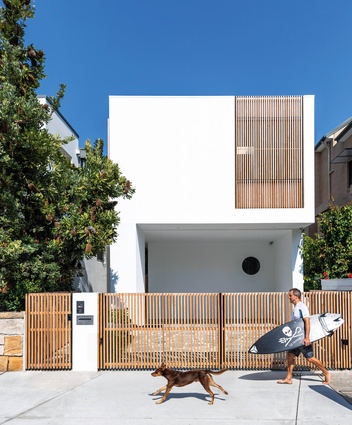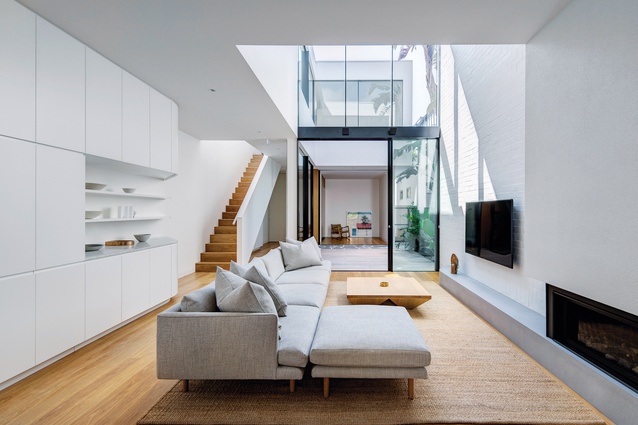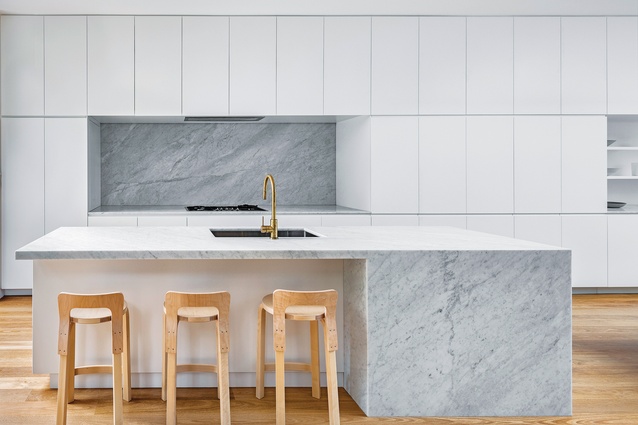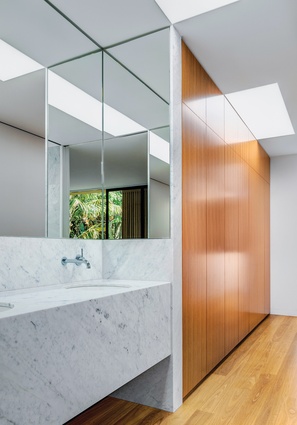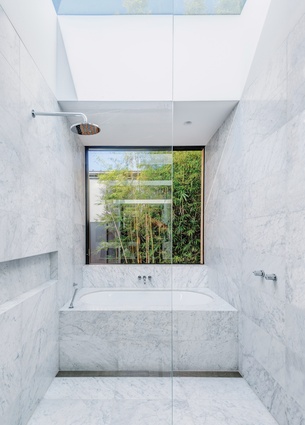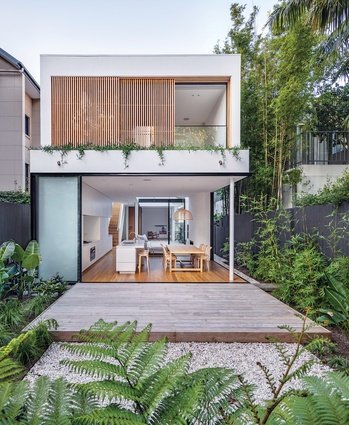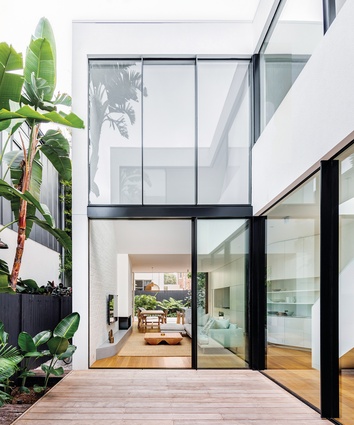Artful apertures: Cloud House
A restful sanctuary for a couple who share their time between Singapore and Sydney, this new house in Bondi by Akin Atelier uses carefully considered apertures and subtle texture to create a sense of unencumbered space and levity.
Some of the most considered decisions an architect makes in the course of a project are often the most discreet in the finished product. They are also an opportunity to learn and investigate new ideas. “This one was about apertures and light and it became a way of testing our experience and understanding,” says Kelvin Ho, founding director of Akin Atelier. Indeed, Akin Atelier’s meticulous attention to junctions and openings heightens the experience of Cloud House, creating the sense of uninterrupted space and the ease of effortless function.
The clients, who live between Singapore and Sydney, wanted a house in Bondi where they could relax and enjoy the outdoors and sunlight, a house that would be a family home in the future.
They also wanted their living space at the rear of the house, but this was the south-facing end of the site.
“It was therefore about how to puncture the volume with apertures of different angles and sizes so that light fractures through to the middle of the building,” Kelvin explains. A courtyard, a double-height glazed wall, a raked ceiling and skylights bring sunlight into the house, with materials that react to the light helping to create an easy, calming environment.
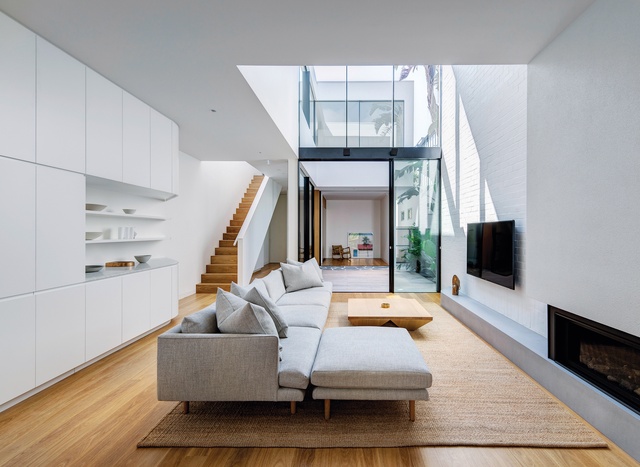
The house is comprised of simple white geometric forms arranged around a central courtyard. The courtyard not only brings northern light into the living area, but also provides the entry to the house, accessed via a bamboo-lined external side walkway. Glazing wraps around the courtyard, with an outdoor shower set among the plantings alongside the fence.
Behind the courtyard, the living, kitchen and dining area is beautiful in its seeming simplicity, but it is also a highly considered composition of materials and forms. A lofty 6.1-metre glazed wall fills the living area with sunlight, accentuating the texture and shadow of the white brick wall.
A raked ceiling and gentle curves subtly guide movement and light deeper into the room as it becomes the kitchen and dining area. A concrete step morphs into a fireplace plinth, shelving and cupboards transition into cabinetry and benchtop, and a still-high three-metre ceiling creates a more intimate sense of space.
Minimalist glass doors open the space to a narrow side garden and rear deck, stacking on the exterior of the house. Akin Atelier knew that the choice of glazing would significantly influence the experience and function of the house, and project architect Georgia McGowan undertook lengthy research and analysis of different window systems, glazed panel sizes and cost comparisons. The designers prioritized slim-profile windows for the most important openings to maximize natural light and the indoor–outdoor connection, and standard profiles on the side elevation for cost-effectiveness.
“The way the doors open up and disappear allows for an extension of the living space and the minimalism of the system contributes to how the space is experienced,” Georgia says. A flush floor finish and a fine-edged steel track enhance the uninterrupted sense of space, with a slim circular column in the corner modestly supporting the upstairs volume.
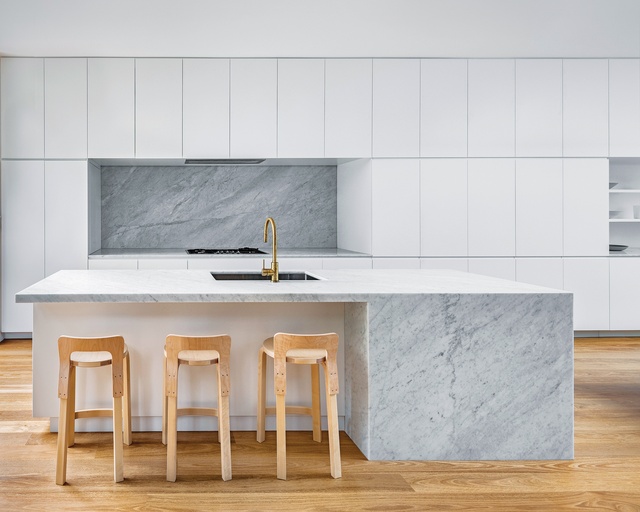
This attention to apertures continues throughout the house. Glass doors in the front room (an adaptable guest bedroom, study or family room) similarly pocket into a wall, out of view. A round window in the bathroom pivots on its horizontal axis and pierces the rectilinearity of the front facade. A skylight extends the length of the staircase, offering views of the sky, and slim-profile windows open upstairs to the courtyard.
The second-floor plan takes guests and future children into account, with two bedrooms
and a bathroom at the front and the main bedroom and ensuite at the back. The passageway provides a threshold between the two and each can be closed off to create contained private spaces.
The clients’ bedroom, bathroom and walk-in robe are arranged around this passage to create a seamlessness of space. Timber wardrobes extend along one wall, divided by the vanity, which sits across the hall from the wet areas.
A skylight bathes the shower in natural light, and timber screens and the neighbour’s bamboo trees create a sanctuary-like atmosphere. The bedroom is also a quiet, calm retreat, with plants that cascade over the edge of the roof below and sliding timber screens provide privacy from the neighbouring apartment blocks.
The design team gave these operable screens thorough attention as another aperture of the house, and the rosewood timber, left to grey, brings natural colour and texture to the exterior. The skylights, likewise, have been elevated above ceiling height to create light and shadow effects as sunlight scatters through the openings.
Throughout Cloud House, the junctions and openings create a continuous and effortless sense
of space as windows, doors and screens seemingly disappear. “This house is about simplicity,” says Kelvin. “You don’t notice when you walk into a space, but you feel it.”
This article first appeared on architectureau.com.

